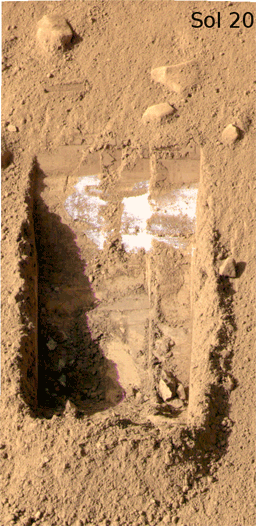Emily Lakdawalla • Jun 19, 2008
Phoenix sol 24: A disappearance from Dodo?
As promised yesterday, Phoenix' sol 24 seems to have been a very busy one for imaging. I've been checking the raw images site regularly throughout the day (using the handy-dandy download tool Mike Howard built into his Midnight Mars Browser software) and about 100 images have rolled in so far from the mast-mounted camera alone. There's only been one from the robotic arm camera so I haven't bothered to update my pages yet. Mark Lemmon has summarized sol 24 as "dig Snow White 2, hit hard stuff." Indeed, they seem to have dug a nice trench perfectly parallel to the original Snow White trench that they dug on sol 20. You can see the "before" image here, and the "after" one here. The two black lines crossing the second image are "data dropouts," and look like the type that typically result from hiccups on the Earth end of the data transmission pipeline. Typically, such images might be flagged as needing to be retransmitted on later communications passes. However, because Phoenix is not saving anything to flash memory right now because of the sol 22 anomaly, my guess is that those images are now gone for good. We'll see. (And no, I haven't heard anything more about the sol 22 anomaly; I'll try to get an update for y'all tomorrow.)

NASA / JPL / UA / Texas A & M / color composite and animation by Daniel Crotty
Disappearing act?
Flipping back and forth between two color images captured on sols 20 and 24 of the Phoenix mission shows that some clods of bright material that were visible in the shadowed part of the trench on sol 20 were no longer there on sol 24. The changes in the sunlit area of the trench should be ignored, as the automatic contrast stretch applied to the raw images released by the Phoenix mission saturated the brightest pixels, but did so differently in the two sets of images, so they cannot be directly compared.Seeing this happen is exactly why the science team is doing "monitoring" of a no-longer-active trench. The team still doesn't know whether the bright material in the trench is ice or salt. It's at the correct depth to be ice, but they haven't gotten that bright material into any of their chemical analysis labs yet. One test they could perform is to see if the bright material changed over time once it was exposed to the Martian sun and wind. If the bright material is ice, you'd expect that the exposure to the dry Martian air and to heating from the Sun would cause it to sublimate -- turn to vapor and disappear.
In this animation, produced from raw images, bright stuff seems to disappear. I won't say that this proves the stuff is ice, because I'm not a member of the science team and I don't have access to the real, calibrated data. But you can bet I've got my ears perked up to see what the science team has to say about this little disappearing act!
The Time is Now.
As a Planetary Defender, you’re part of our mission to decrease the risk of Earth being hit by an asteroid or comet.
Donate Today

 Explore Worlds
Explore Worlds Find Life
Find Life Defend Earth
Defend Earth

